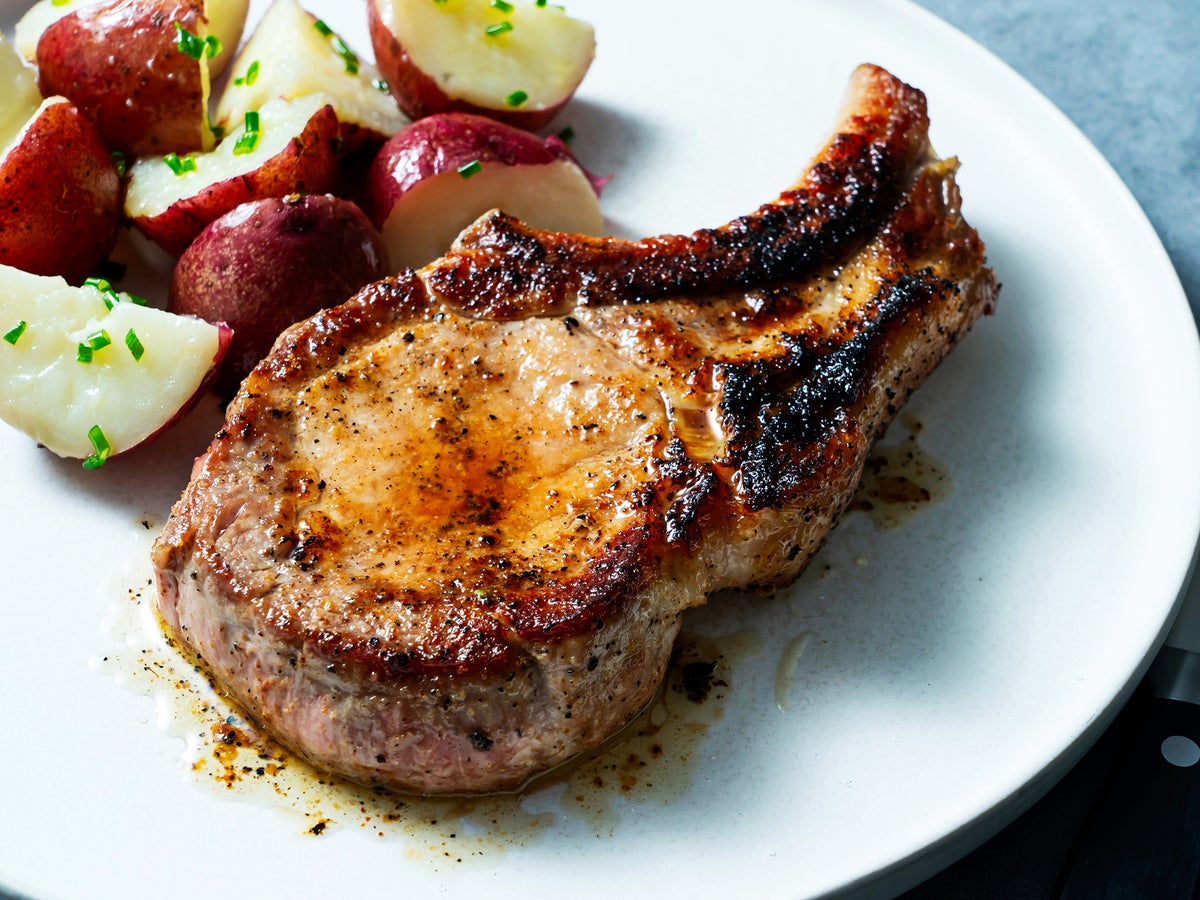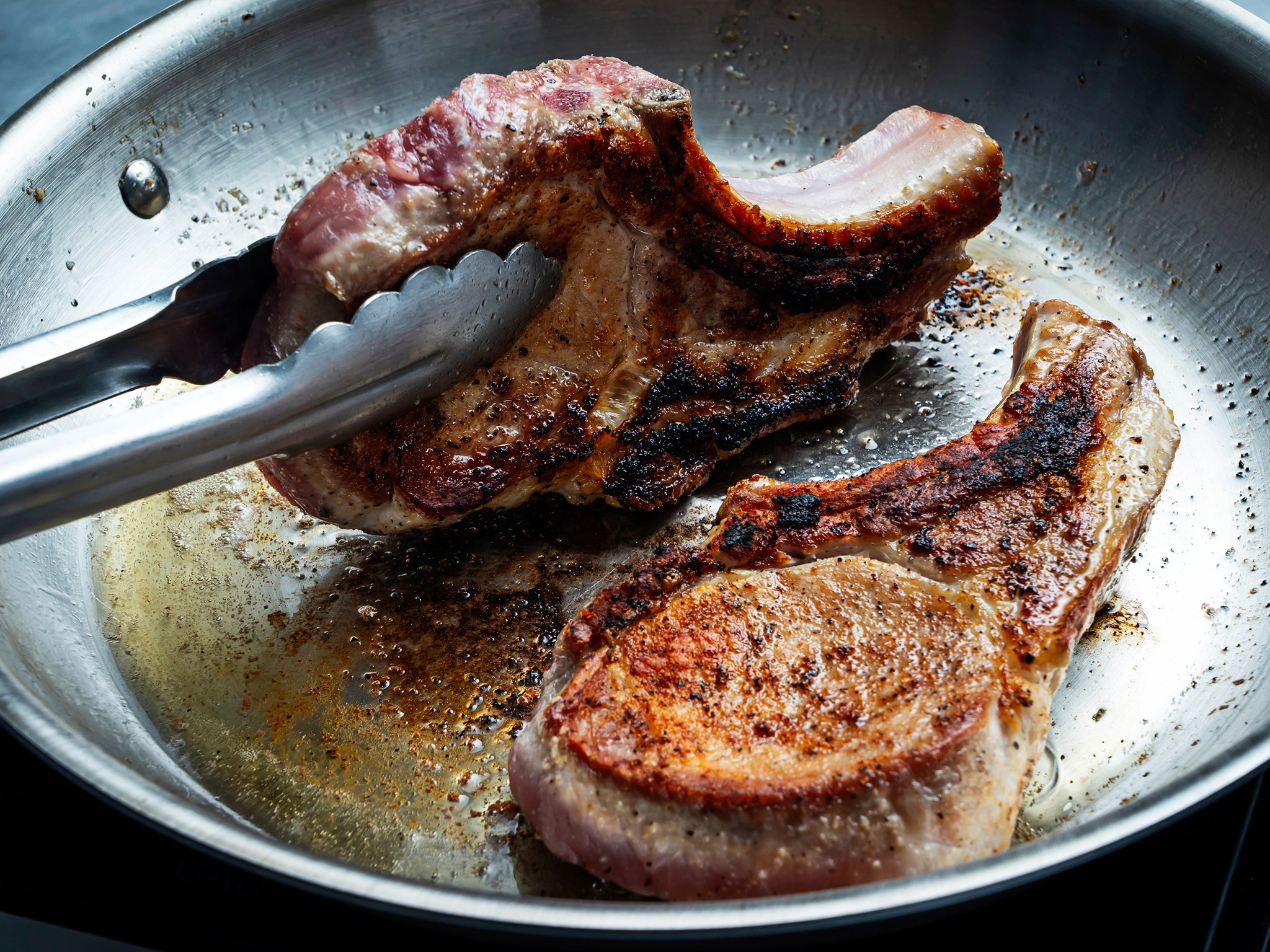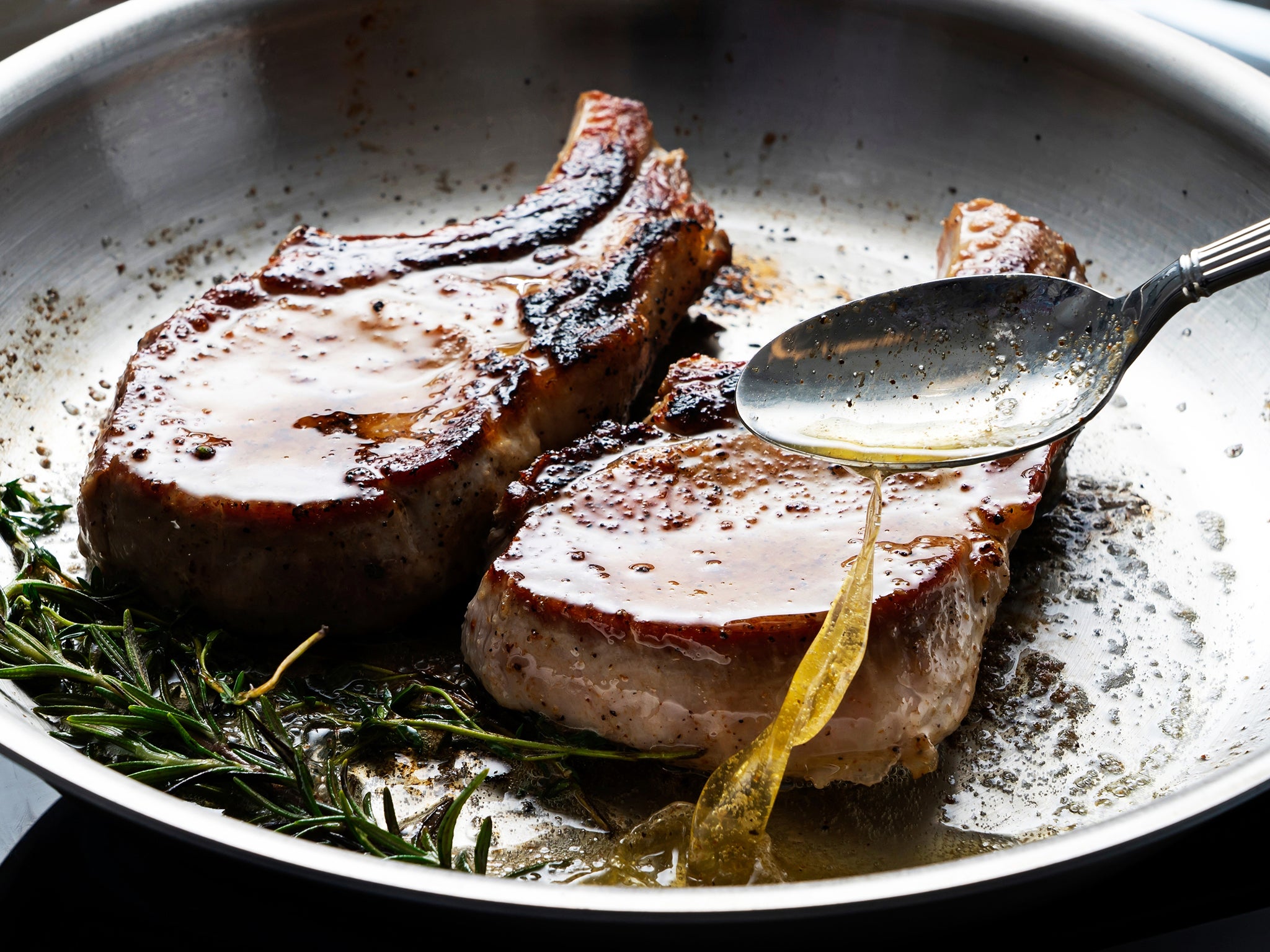
A good pork chop is a thing of beauty. When handled properly – with a nicely caramelised crust encasing moist, flavourful meat – it can give even your favourite cut of steak a run for its money. But anyone who has eaten this cut of meat often has likely encountered at least one tough, dry chop, compelling them to try to choke it down anyway to save face or avoid food waste.
The oven is one avenue for avoiding dried-out pork chops, but that can take more time than I am willing to devote on a weeknight. When I’m hungry, cooking pork chops on the stove can get them onto my plate in minutes, but without the right care these weeknight warriors can easily turn into shoe leather.
For fast, moist and juicy pork chops on the stove, here’s what you need to know.
Choose the right pork chop cut
Cooking great pork chops starts at the supermarket. They come in a variety of cuts and thicknesses, but the best choice for searing in a pan is bone-in, thick cut chops. The bone slows down the cooking process ever so slightly, which can be a lifesaver for lean cuts of meat. My personal favourite cut has the curved bone on one side. These can be labelled rib or centre cut chops, but porterhouse or loin chops, which have a T-shaped bone, also work for quick-cooking meals (sirloin chops require braising).
In terms of thickness, I find one inch to be the sweet spot. “Thin cuts easily dry out, because by the time you get the outside sufficiently seared, the meat inside is overdone,” my colleague Becky Krystal wrote, and they are better reserved for frying. “Thick cuts can be hard to get an even cook on, because you may overcook the outside before the inside can even finish.” So unless you’re confident in your cookery, save the extra-thick, double-cut pork chops for the pros.
Brining pork chops is not necessary
In a quest to find “the absolute best way to make juicy pork chops”, food writer Ella Quittner wrote in Food52 that a wet brine “produced the juiciest chop, by a landslide” in a comparison against dry-brined and un-brined meat. However, when it came to a caramelised exterior, the wet-brined chops “had the worst, because moisture is the enemy of crispiness”.
I find brining to be completely unnecessary – and I’m not alone. “Not only is brining unnecessary for making tender pork chops, it can also introduce a lot more water to your meat, which will not improve its texture,” Joe Sevier wrote in Epicurious. Plus, brining adds to the prep time that I don’t have when I want to eat dinner imminently, so I say skip it. If you must brine, be sure to thoroughly pat the chops dry with a towel before searing them in the pan.
Rest the meat on the counter before cooking
Removing the pork chops from the refrigerator 30 minutes before cooking leads to a more even cook. Admittedly, it wasn’t very noticeable in the 1-inch-thick chops that I experimented with, but I posit it makes a larger difference for thicker chops.
A more distinct difference is that letting the meat sit a room temperature before searing reduces the overall cook time by a few of minutes. So when it’s time to prepare a meal, simply take the pork chops out of the fridge first before starting on your other dishes. Once those are well underway, you’ll have knocked the chill off the meat and you’ll get more even results.

Fat is key to keeping pork chops moist
The leanness of pork chops is what makes this cut a weeknight favourite, but it also means they can easily become tough and dry. The solution? Basting them with fat, such as butter. Add in aromatics while basting for more flavour – similar to how you might cook a steak – and then you have the added bonus of browned butter and crispy garlic and/or herbs to serve with the meat. (Yum!)
Don’t overcook the pork chops – and let them rest
Perhaps the most important tip is not to overcook your pork chops. Growing up, I was taught that pork must be well done to be safe to consume, but the recommended safe cooking temperature has since been lowered from 71C to 62C with a three-minute rest, meaning that you can enjoy a medium pork chop just as you might a medium steak. (I prefer taking pork chops out of the pan at 57C before resting, loosely tented with foil, for 5 minutes where the temperature should rise to 62C, which is considered medium-rare.) If you don’t have one already, now would be the time to invest in an instant-read thermometer, and before you know it you’ll be enjoying juicy, tender pork chops in no time.
Butter-basted pork chops

Active time: 15 minutes | Total time: 20 minutes
Serves: 2 to 4
Though pork chops can be fast and flavourful, they can also easily dry out. More time-consuming dual cooking methods or brining can lead to juicy results, but there’s an easier shortcut to moist, delicious pork chops: butter.
The leanness of pork chops is what makes this cut a quick-cooking, weeknight warrior, but it also means they can quickly get dry and tough. Basting the chops with fat helps negate this. Add in aromatics while basting for more flavour – similar to how you might cook a steak – and then you have the added bonus of browned butter and crispy garlic or herbs to serve with the meat.
The other key is to not overcook the chops. Contrary to what you may have learned years ago, it is perfectly safe to eat pork that isn’t well done. An instant-read thermometer is great for determining the precise temperature, but you can also go by feel of the meat with enough practice (reducing the heat once you get a nice sear on one side also lowers the risk of overcooking the meat – and burning the butter).
Following the steps below will lead you to pork chop success, and once you’ve nailed down the technique, feel free to make this recipe your own by switching up the seasonings.
Storage notes: Refrigerate leftovers for up to 3 days.
Ingredients:
Two (340g) centre-cut, bone-in pork chops, about 2½cm-thick
½ teaspoon garlic powder
½ teaspoon freshly ground black pepper
¼ teaspoon fine salt
1 tablespoon vegetable oil or another neutral oil
2 tablespoons unsalted butter
Crushed garlic cloves, fresh thyme sprigs, fresh rosemary sprigs and/or fresh sage sprigs
Method:
Remove the pork chops from the refrigerator and transfer to the counter for 30 minutes (optional, see note). Pat the meat dry with a clean dish towel or paper towel, and sprinkle all over with the garlic powder, pepper and salt.
In a 25-30cm stainless steel or cast-iron frying pan over medium-high heat, heat the oil until shimmering. And the pork chops and cook, pressing with tongs occasionally to ensure they have good contact with the pan, until nicely browned, 3 to 4 minutes.
Reduce the heat to medium and, using tongs, stand the chops on their side in the pan, fat side down, to render some of the fat, about 1 minute. Lay the chops down on the uncooked side; add the butter, crushed garlic cloves, fresh thyme sprigs, fresh rosemary sprigs and/or fresh sage sprigs; and cook, regularly tilting the pan and using a large spoon to baste the chops with the butter, until the meat has an internal temperature of about 57C, 4 to 8 minutes (see note). Transfer the pork chops to a cutting board, serving platter or individual plates, cover loosely with foil and let rest for 5 minutes. (During this time, the internal temperature of the meat should rise to 62, which is considered medium-rare.) Serve hot with the butter and the aromatics from the skillet poured over the top, if desired.
Note: Letting the pork chops rest at room temperature before cooking reduces the overall cooking time by a few minutes and ensures a slightly more even cook.
Nutrition information per serving, based on 4 | calories: 300; total fat: 16g; saturated fat: 6g; cholesterol: 133mg; sodium: 247mg; carbohydrates: 1g; dietary fibre: 0g; sugar: 0g; protein: 38g.
This analysis is an estimate based on available ingredients and this preparation. It should not substitute for a dietitian’s or nutritionist’s advice.
© The Washington Post







